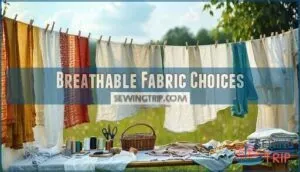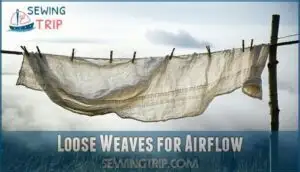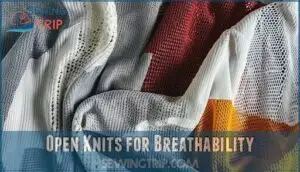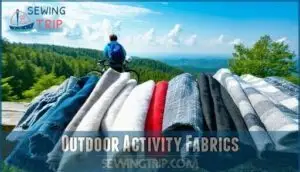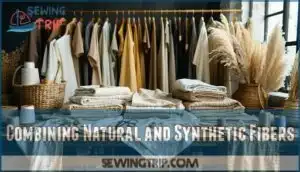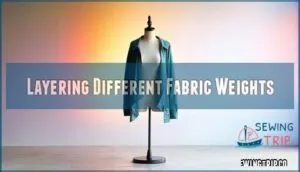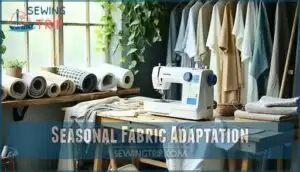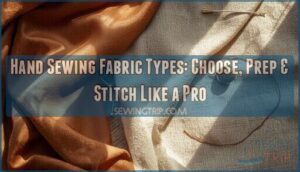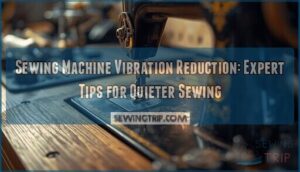This site is supported by our readers. We may earn a commission, at no cost to you, if you purchase through links.
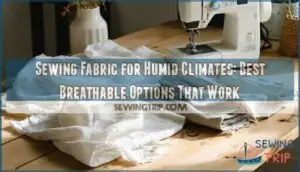
Lightweight cotton voile and linen are your best friends – they wick moisture away from your skin and dry quickly.
Bamboo fabric offers natural antimicrobial properties, while cotton-linen blends give you the perfect balance of comfort and durability.
Skip heavy fabrics that’ll turn you into a walking sauna.
Loose weaves like seersucker create air pockets that keep you cool, and light colors reflect heat better than dark ones.
The secret isn’t just the fiber type – it’s understanding how weave structure affects airflow and moisture management.
Table Of Contents
- Key Takeaways
- Humid Climate Fabrics
- Breathable Fabric Choices
- Fabric Weave and Construction
- Color Selection for Humidity
- Fabric Weight and GSM
- Outdoor Activity Fabrics
- Layering for Temperature Changes
- Mixing Fabrics for Unique Looks
- Fabric Care and Maintenance
- Seasonal Fabric Adaptation
- Frequently Asked Questions (FAQs)
- Conclusion
Key Takeaways
- You’ll want to choose natural fibers like linen, cotton voile, and bamboo that breathe naturally and wick moisture away from your skin, avoiding heavy fabrics that trap heat and create a sauna effect.
- Pick loose weaves and open constructions like seersucker that create air pockets for ventilation, since tight weaves trap heat and dampness against your body.
- Opt for light colors and pastels that reflect heat instead of dark shades that absorb sunlight and raise your body temperature in humid conditions.
- Select lightweight fabrics under 200 GSM for maximum airflow and quick moisture evaporation, while heavier weights above 200 GSM will trap heat and sweat.
Humid Climate Fabrics
When you’re sewing for humid weather, you’ll need fabrics that move moisture away from your skin and allow air to circulate freely.
Choose fabrics that breathe with you, not against you—your comfort depends on smart material decisions.
The right fabric choice makes the difference between staying comfortable and feeling sticky all day, whether you’re choosing natural fibers like linen and cotton or exploring synthetic alternatives that wick sweat efficiently.
Natural Fiber Options
When choosing breathable fabrics for humid weather, natural fibers deliver unmatched comfort.
Linen benefits include superior moisture wicking and quick drying.
Cotton types like voile offer versatility, while silk properties provide temperature regulation.
Bamboo fabric combines sustainability with antimicrobial features.
These organic choices create lightweight materials that allow your skin to breathe naturally, making humid days bearable.
Synthetic Fiber Alternatives
Synthetic fibers offer compelling moisture-wicking solutions when natural options aren’t available.
These engineered materials excel at pulling sweat away from your skin, though they require careful selection to avoid heat-trapping disasters.
Your best synthetic choices include:
- Polyester blends – Mix breathability with quick-dry performance
- Rayon options – Mimic silk’s cooling properties affordably
- Nylon alternatives – Lightweight moisture management for active wear
- Microfiber substitutes – Ultra-fine fibers enhance airflow substantially
Blending Fabrics for Comfort
Perfect harmony emerges when you combine natural fibers with synthetic materials.
Perfect balance blooms when natural breathability meets synthetic performance—creating fabrics that work as hard as you do.
Cotton-polyester blends offer breathable textures while maintaining durability. Linen-bamboo hybrid materials provide superior moisture management without sacrificing comfort weaves.
These fabric blends give you the best of both worlds—natural fibers’ breathability with synthetic moisture wicking properties.
Lightweight materials become powerhouses for humid climates.
Breathable Fabric Choices
You’ll find that choosing the right breathable fabrics makes all the difference when sewing garments for sticky, humid weather.
The best options combine natural fibers like linen and cotton with modern moisture-wicking technologies to keep you comfortable and dry throughout the day.
Linen and Cotton Benefits
Between linen textiles and cotton blends, you’ll discover two powerhouse natural fibers for summer comfort.
Linen’s hollow structure releases moisture twice as fast as cotton, delivering superior natural cooling.
Cotton offers consistent fabric softness but holds moisture longer.
Both breathable fabrics excel at moisture wicking, though linen outperforms cotton in humid conditions for ideal temperature regulation.
For the best results, consider the moisture wicking properties when choosing between these fabrics, focusing on ideal temperature regulation and breathable fabrics.
Silk and Bamboo Properties
Beyond cotton’s popularity, silk benefits include natural temperature regulation that keeps you cool when it’s hot.
Bamboo fabric offers superior moisture wicking properties while remaining completely sustainable.
These natural fibers excel at breathability—silk fabrics feel luxurious yet practical, while bamboo provides antimicrobial protection.
Both materials work harder than synthetic alternatives, making them ideal sustainable textiles for humid weather sewing projects.
Moisture-Wicking Fabric Technologies
High-tech moisture-wicking fabrics use specialized fiber structures that pull sweat away from your skin’s surface through capillary action.
These fabric innovations feature engineered channels that transport moisture to outer layers where it evaporates quickly.
Smart textiles now incorporate phase-change materials for active temperature regulation.
Modern breathable materials combine quick-drying properties with antimicrobial treatments for superior moisture management.
The latest advancements in sweat absorption technology have led to significant improvements in fabric performance and comfort.
Fabric Weave and Construction
You’ll find that the way your fabric is woven determines how well air moves through it, making the difference between staying cool and feeling sticky in humid weather.
Loose weaves and open constructions create pathways for airflow and moisture evaporation, while tight weaves trap heat and dampness against your skin, which is crucial for understanding how to stay cool in humid conditions, particularly in relation to moisture evaporation.
Loose Weaves for Airflow
Choosing loose weaves transforms your humid-weather wardrobe into a personal cooling system.
Linen weaves and breathable textures allow maximum airflow through open fabric construction, while loose threads create natural ventilation channels.
These airflow fabrics promote moisture-wicking and quick dry performance by letting air circulate freely around your body, keeping you comfortable when temperatures soar with maximum airflow.
Open Knits for Breathability
While loose weaves excel at ventilation, open knits take breathability to another level.
These knit patterns create natural air pockets that promote moisture management through enhanced airflow fabrics. You’ll find breathable yarns in open weave construction allow sweat to evaporate quickly, making these breathable textiles perfect for humid conditions.
- Jersey knit with enlarged loops that create visible gaps between stitches
- Mesh-style patterns featuring diamond or hexagonal openings for maximum ventilation
- Loosely constructed cable knits with twisted yarn formations allowing air circulation
Seersucker Texture Advantages
Seersucker’s distinctive puckered texture creates natural air pockets that elevate it among breathable fabrics for humid climate clothing.
These raised ridges allow constant airflow against your skin, delivering superior cooling effects compared to flat weaves.
The texture benefits include enhanced moisture management and lightweight comfort. This traditional fabric proves that sometimes old-school solutions work best for modern moisture wicking needs.
Color Selection for Humidity
When you’re choosing fabric colors for humid weather sewing projects, you’ll want to prioritize light shades that reflect sunlight and keep you cooler throughout the day.
Dark colors absorb more heat and can make you feel uncomfortably warm, while pastels offer a stylish middle ground that provides both heat reflection and visual appeal.
Light Colors for Heat Reflection
Color theory plays a bigger role in humid climate comfort than you’d think.
Light colors work like natural air conditioning for your skin, reflecting heat instead of absorbing it.
- White and cream fabrics reflect up to 90% of sunlight
- Pastel shades offer style while maintaining heat reflection benefits
- Summer hues like pale yellow keep you cooler than darker alternatives
Light fabrics in these colors enhance breathable, moisture-wicking performance.
Dark Colors for Heat Absorption
Dark colors trap heat like magnets, making you a walking furnace in humid weather.
Navy, black, and deep burgundy absorb sunlight, raising your body’s color temperature and creating thermal retention nightmares.
While these dark shades look sophisticated, they work against fabric breathability and moisture-wicking properties.
Your clothing becomes a heat prison when fabric dye darkness meets blazing sun and sticky air, creating a situation where dark colors effectively trap heat like magnets.
Pastel Shades for Balance
Pastel shades offer the perfect middle ground when you’re torn between staying cool and looking stylish.
These lightweight fabrics in soft pinks, blues, and lavenders reflect enough heat to keep you comfortable while adding visual interest to your wardrobe.
Color theory proves that pastel hues work brilliantly with natural fibers and moisture-wicking fabrics for humid weather balance.
Fabric Weight and GSM
You’ll find that fabric weight, measured in GSM (grams per square meter), directly affects how well your garments perform in humid conditions.
Lightweight fabrics under 150 GSM allow maximum airflow and quick moisture evaporation, while heavier weights above 200 GSM can trap heat and sweat against your skin, which is related to humidity conditions.
Lightweight Fabrics for Comfort
Choose lightweight fabrics under 200 GSM for superior comfort in humid conditions.
These breathable fabrics enhance air circulation while providing excellent moisture wicking properties.
Natural fibers like cotton voile and linen offer exceptional fabric breathability, while synthetic quick dry fabrics excel during active wear.
Summer fabrics in lighter weights prevent overheating and maintain freshness throughout sweltering days, making them ideal for superior comfort and breathable conditions.
Medium Weight Fabrics for Versatility
When temperatures fluctuate throughout the day, medium weight fabrics become your go-to solution for humid climate clothing.
These versatile knits and breathable weaves offer the perfect balance between comfort and durability, making them ideal for seasonal weather.
- Fabric blends combining cotton and synthetic fibers deliver superior moisture-wicking performance
- Medium cotton provides reliable breathability without sacrificing structure or longevity
- Smart textiles adapt to changing conditions while maintaining consistent comfort levels
- Quick dry fabrics guarantee you stay fresh during unpredictable humidity shifts
Heavy Fabrics for Cold Weather
While medium weights offer versatility, heavy fabrics become your climateready armor when temperatures drop.
Wool blends and fleece fabrics provide exceptional thermal insulation for winter wear textiles. These insulating wools trap warm air effectively, though they’re unsuitable for warm climates.
| Fabric Type | GSM Range | Best Use |
|---|---|---|
| Heavy Knits | 300-500 | Sweaters, coats |
| Fleece Fabrics | 200-400 | Outdoor layers |
| Wool Blends | 250-450 | Cold weather comfort |
Outdoor Activity Fabrics
When you’re planning outdoor activities in humid weather, you’ll need fabrics that can handle sweat and moisture while keeping you comfortable.
Performance synthetics like nylon and polyester blends excel at wicking moisture away from your skin.
While natural fibers like lightweight cotton and linen work better for casual outdoor activities where breathability matters more than intense moisture management.
Performance Fabrics for Exercise
When you’re breaking a sweat, synthetic fibers become your best workout buddies.
They are moisture-wicking champions that pull perspiration away from your skin faster than natural fabrics ever could.
Athletic wear featuring polyester blends and nylon delivers superior quick-dry performance, keeping you comfortable during intense sessions.
Modern sportswear combines breathable fabrics with sweat-resistant technology for ideal moisture management.
The use of advanced moisture wicking materials has substantially improved the overall performance of athletic wear.
Natural Fibers for Casual Wear
Natural fibers deliver unmatched comfort for casual outdoor wear.
Linen benefits include superior airflow and quick moisture-wicking properties that keep you fresh. Cotton comfort comes from its breathable nature and soft feel against skin.
Silk properties offer temperature regulation, while bamboo fabric provides antimicrobial protection.
These organic textiles create lightweight linens and cotton blends perfect for humid adventures.
Water-Resistant Fabrics for Water Sports
When you’re hitting the waves or kayaking, you’ll need water repellent fabrics that balance protection with breathability.
Waterproof membranes like Gore-Tex create an effective moisture barrier while allowing sweat to escape. Quick dry nylon with fabric coatings handles splashes beautifully.
For serious water sports, waterproof materials with moisture management systems keep you comfortable. These breathable fabrics with waterrepellent treatments make all the difference.
Considering the fabric selection process is vital for superior performance in humid climates.
Layering for Temperature Changes
You’ll need a strategic approach to layering when humidity meets temperature fluctuations throughout the day.
Start with moisture-wicking base layers, add breathable mid-layers for insulation.
Finish with lightweight outer layers that protect against wind while maintaining airflow.
Base Layers for Moisture-Wicking
Your base layer acts as your skin’s best friend in humid weather.
Choose moisture-wicking fabrics like merino wool or synthetic blends that pull sweat away from your body.
These breathable materials offer superior thermal regulation and quick-dry properties.
Natural fibers provide comfort, while synthetic options excel at moisture management.
Your sweat-resistant foundation determines your entire day’s comfort level.
Mid-Layers for Insulation
Your base layer handles sweat, but you’ll need smart mid-layer materials when temperatures drop.
Breathable midlayers trap warm air while allowing moisture to escape, preventing that clammy feeling. Fleece options and insulating synthetic fibers work better than cotton, which loses thermal insulation when wet.
When choosing fabrics, understanding fabric weight considerations is essential for superior performance.
- Merino wool blends – Natural breathable fabrics with excellent moisture-wicking properties
- Synthetic fleece – Lightweight insulating fabrics that dry quickly
- Down alternatives – Moisture-wicking synthetics that maintain loft when damp
Outer Layers for Wind Protection
Your mid-layer handles insulation, but you’ll need outer shells when wind picks up.
Wind breakers made from tightly woven fabrics offer weather resistance while maintaining breathability.
Look for garment design that balances fabric density with airflow – lightweight fabrics with DWR coatings work best.
These breathable clothing options protect against gusts without trapping moisture like traditional rain gear would.
Mixing Fabrics for Unique Looks
You can achieve stylish looks while maintaining comfort by strategically combining different fabric types that complement each other’s performance properties.
This approach lets you create garments that blend natural fibers’ breathability with synthetic materials’ moisture-wicking capabilities for ideal humid weather wear.
Combining Natural and Synthetic Fibers
Smart sewers know that Fabric Blends create superior performance for humid weather projects. Combining natural and synthetic fibers gives you the best of both worlds – breathable natural fibers meet moisture-wicking synthetics for ultimate comfort.
Here’s how to master Mixed Materials:
- Cotton-polyester blends offer durability with breathability
- Linen-nylon combinations add strength to delicate natural fibers
- Bamboo-spandex mixes provide stretch while maintaining antimicrobial properties
- Silk-polyester Hybrid Textiles balance luxury feel with easy care
These Natural Upgrades with Synthetic Enhancements create breathable textiles that outperform single-fiber options. Understanding natural fiber blends is essential for selecting the right materials for your sewing projects.
Layering Different Fabric Weights
Strategic fabric layering combines different weight options to create versatile garments that adapt to changing conditions.
You’ll achieve ideal thermal management by pairing lightweight breathable textiles with medium-weight moisture-wicking fabrics.
This fabric blending approach works exceptionally well in humid climates where temperature fluctuations demand adaptable clothing solutions.
| Layer Position | Fabric Weight | Best Materials |
|---|---|---|
| Base Layer | Lightweight (80-120 GSM) | Bamboo, Merino Wool |
| Mid Layer | Medium (150-200 GSM) | Cotton Blends, Linen |
| Outer Layer | Variable (100-300 GSM) | Performance Synthetics |
| Accent Pieces | Ultra-light (60-100 GSM) | Silk, Voile Cotton |
Pattern Selection for Different Seasons
Seasonal patterns reveal your fabric layering potential through weather forecasting and garment planning.
Climate considerations guide your fabric selection decisions perfectly.
Choose these seasonal fabric selection strategies:
- Spring florals with breathable materials like cotton voile
- Summer geometrics using moisture-wicking fabrics and natural fibers
- Fall plaids combining lightweight wools with performance synthetics
Your wardrobe adapts seamlessly.
Fabric Care and Maintenance
You’ve invested in the perfect breathable fabrics for humid weather, but proper care determines how long they’ll keep you comfortable.
Understanding specific washing and drying techniques for natural fibers, synthetics, and antimicrobial treatments guarantees your garments maintain their moisture-wicking properties and performance through countless wear cycles.
Washing and Drying Natural Fibers
Hand washing preserves natural fibers’ moisture-wicking and breathability properties better than machines.
Use natural detergents to prevent fabric shrinkage and maintain fiber integrity.
Gentle drying techniques like air-drying protect delicate weaves from heat damage.
Skip the dryer for linen and cotton—high temperatures destroy their cooling abilities.
Proper washing techniques extend your humid-climate fabrics’ lifespan substantially, using methods that preserve the natural properties of the fibers, such as moisture-wicking.
Caring for Synthetic Fibers
Why struggle with synthetic fabric care when simple steps keep your moisture-wicking garments performing like new?
Wash polyester and microfiber in cold water to preserve their breathable properties. Skip fabric softening—it clogs synthetic fibers and reduces their humidity management abilities.
Air-dry when possible, or use low heat settings. Proper synthetic washing and fiber drying maintain peak performance in humid climates.
Following good fabric care tips is essential for extending the life of your garments and ensuring they remain breathable with good humidity management.
Specialized Cleaning for Antimicrobial Treatments
Most antimicrobial treatments require gentle washing to maintain their microbe removal effectiveness.
You’ll need specialized fabric sanitizing methods that won’t strip protective coatings from moisture-wicking fabrics. Follow manufacturer guidelines for antimicrobial care, using mild detergents and cool water temperatures.
Treatment maintenance becomes essential in humid climates where antimicrobial fabric technology works hardest against bacterial growth. Understanding antimicrobial fabric properties is essential for effective treatment and care.
Seasonal Fabric Adaptation
You’ll need different fabric strategies as humidity levels shift throughout the year, from lightweight linens in summer’s peak heat to seasonal cotton blends during milder months.
Smart seasonal adaptation means selecting fabrics that work with your local climate patterns, ensuring you stay comfortable whether you’re facing spring’s unpredictable weather or winter’s unexpected warm spells, which requires smart choices and an understanding of local climate patterns.
Spring and Summer Fabric Choices
Your spring and summer fabric selection becomes your secret weapon against sticky, uncomfortable days.
Cotton offers superior breathability and moisture-wicking properties for maximum comfort.
Lightweight linens provide unmatched airflow capacity in extreme heat.
Bamboo fabric excels in moisture absorption, making it perfect for t-shirts and undergarments.
Natural fibers like voile deliver exceptional performance in humid conditions, utilizing natural fibers.
Autumn and Winter Fabric Choices
Cooler months don’t mean abandoning breathable principles.
You’ll want thermal insulation that still allows airflow – think merino wool sweaters and bamboo-cotton blends.
Winter knits in natural fibers provide warmth without trapping moisture.
Fleece fabrics work well for cold weather layering, while insulating wools offer climate control.
Choose seasonal textures that breathe while keeping you cozy.
Transitional Fabrics for Changing Seasons
You’ll master fabric evolution by choosing seasonal blends that adapt as temperatures shift.
Cotton-modal blends offer thermal layers without bulk, while bamboo-polyester combinations provide climate adaptation through spring’s unpredictable weather.
These textile evolution choices combine natural fibers with synthetic blends for superior moisture-wicking and breathability.
Climate control fabrics like merino-silk blends give you flexibility when morning chill meets afternoon warmth.
Frequently Asked Questions (FAQs)
What thread types work best in humidity?
You’ll want polyester or cotton-wrapped polyester threads for humid conditions.
They resist moisture better than pure cotton, won’t weaken when damp, and maintain tension consistency.
Avoid silk threads—they’ll absorb humidity and potentially shrink your seams.
How does humidity affect sewing machine tension?
High humidity swells thread and fabric, throwing off your machine’s delicate balance.
You’ll need to loosen upper tension slightly and adjust presser foot pressure.
Test on scraps first—humid air makes everything behave differently than expected.
Which interfacing materials prevent moisture buildup?
Like armor against moisture’s invasion, breathable fusible interfacings made from cotton or bamboo fibers let air circulate freely.
You’ll avoid soggy fabric layers by choosing lightweight, non-woven options that won’t create humidity traps, thus ensuring a more comfortable and dry experience with breathable materials.
Do preshrinking methods differ for humid climates?
Yes, you’ll need extra care when preshrinking fabrics for humid climates.
Natural fibers like linen and cotton require longer soaking times, while synthetic blends need gentler heat to prevent fiber damage from moisture retention.
What seam finishes prevent fabric deterioration?
French seams and bound seams protect raw edges from moisture-induced fraying.
You’ll also want serged edges or zigzag stitching for durability.
These techniques create barriers against humidity that’ll keep your garments looking fresh longer, using methods like bound seams.
Conclusion
While heavy fabrics trap heat and moisture, the right sewing fabric for humid climates transforms your wardrobe into a cooling system.
You’ve learned that natural fibers like linen and cotton voile breathe naturally, while synthetic blends offer moisture-wicking performance.
Loose weaves create airflow, light colors reflect heat, and proper fabric weight makes all the difference.
Whether you’re crafting casual wear or performance pieces, choosing breathable materials guarantees comfort when temperatures and humidity soar, making a significant difference in your overall wardrobe comfort with the right natural fibers.
- https://www.fabricfits.com/best-fabric-for-hot-weather/
- https://sewingiscool.com/list-of-breathable-fabrics-for-hot-weather/
- https://knowingfabric.com/best-fabrics-for-hot-and-humid-weather/
- https://www.blogpingshop.com/staying-cool-in-the-heat-the-best-fabrics-for-hot-humid-climates.html
- https://www.ownkoti.com/blogs/news/best-fabric-for-hot-humid-weather

